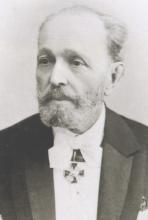
Marius Petipa
Marius Petipa (1818-1910), son of the French ballet master Jean Petipa, made his debut as dancer in 1828, in a version of Pierre Gardel’s Le Dansomanie staged by his father. In 1847, he was engaged as a dancer with the Imperial Theatres in St Petersburg. Seven years later, he became a teacher at the Imperial Ballet School in the same city.
Following the success of the first ballet he created in Russia, A Regency Marriage, he was appointed assistant choreographer at the Imperial Theatres in 1862. It was only when the chief choreographer, Arthur Saint-Léon, was forced to resign in 1869 that Petipa got the chance to blossom. Petipa then occupied the position of chief choreographer for almost forty years.
Petipa’s value to classical ballet cannot be estimated highly enough. It was through him that ballet evolved into the art form we know today. The scope of his oeuvre is enormous. In Russia alone, he created over 75 ballets and dozens of divertissements and opera intermezzos. His collaboration with Tchaikovsky, which resulted in the three famous ballets The Sleeping Beauty, The Nutcracker and Swan Lake, came at the end of his illustrious artistic career. Petipa died in 1910 at the age of 92.